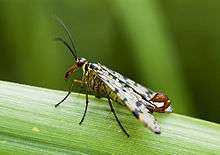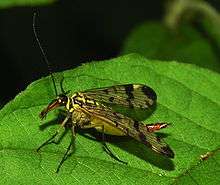Panorpa communis
| Panorpa communis | |
|---|---|
 | |
| P. communis male | |
 | |
| P. communis female | |
| Scientific classification | |
| Kingdom: | Animalia |
| Phylum: | Arthropoda |
| Class: | Insecta |
| Order: | Mecoptera |
| Family: | Panorpidae |
| Genus: | Panorpa |
| Species: | P. communis |
| Binomial name | |
| Panorpa communis Linnaeus, 1758 | |
Panorpa communis, the common scorpionfly,[1] is a species of scorpionfly native to Western Europe.
Description
_female.jpg)
The common scorpionfly has a black and yellow body, with a reddish head and tail. The male has a pair of claspers at the end of its tail (for holding the female during mating), giving it a scorpion-like appearance, although it is not a stinger. The adult insect has a wingspan of about 35 millimetres (1.4 in), with wings that are mostly clear, but have many dark spots or patches. Its head, mounted with large eyes, is drawn into a prominent, downward pointing beak, which opens at the tip of its head. The larva resembles a caterpillar and grows up to 20 millimetres (0.79 in) long. It has three pairs of thoraxic legs and eight pairs of prolegs.
Habits
The adult is seen between May and September, and can be usually found in hedgerows and patches of nettle. They eat dead insects (although they sometimes eat live aphids), sometimes taking them from spider webs.[2]
Although fully winged, the adults rarely fly very far and spend much of their time crawling on vegetation in damp, shaded places near water and along hedgerows. Eggs are laid in soil annually and the larvae both scavenge and pupate there.
References
| External identifiers for Panorpa communis | |
|---|---|
| Encyclopedia of Life | 4129199 |
| NCBI | 52816 |
| Also found in: Wikispecies | |
- ↑ in Kendall Bioresearch
- ↑ "food" in uksafari.com
